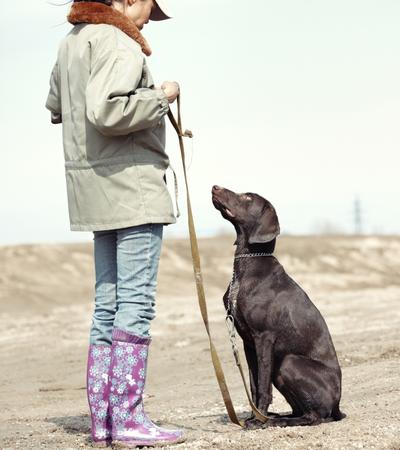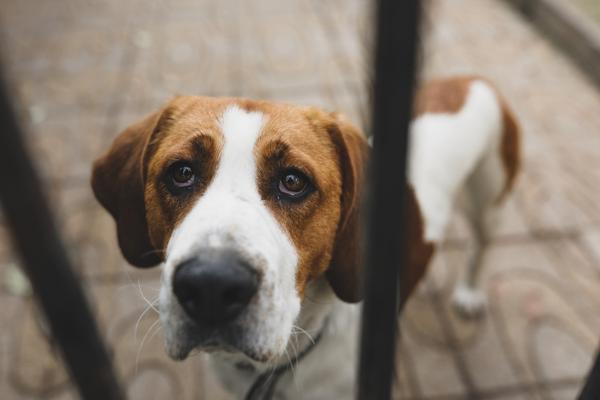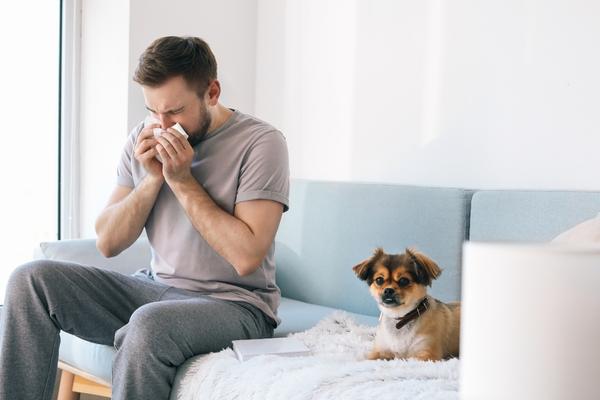What are Dog Allergies In Humans?
If being around dogs makes you feel like you have a cold – with a runny nose, watery eyes, and an itchy throat – you’re probably allergic to them. You’ll notice that your symptoms get worse if you pet a dog, or you sit or lay down in a place where dogs sit or sleep.
So What Actually Makes Humans Allergic To Dogs?
The major causes of having allergic reactions to dogs is a protein that’s found in their skin and saliva. Your body reacts to that protein when you inhale it, or touch it, and it triggers an allergic response. 
Dog Allergy Symptoms
- Sneezing, coughing, or wheezing
- Watery eyes
- Red, itchy eyes
- Runny or stuffy nose
- Skin rashes
What Is A Hypoallergenic Dog?
A hypoallergenic dog is a dog that is less likely to trigger an allergic response in humans. Hypoallergenic dogs usually shed less, or hardly at all. Because they don’t shed much, their dander doesn’t usually make it to the floor or into the air – so you don’t come into contact with it. If you’re allergic to dogs, there’s no dog out there that can be completely guaranteed to not cause allergic symptoms. In fact, if you cut off all your dog’s hair, smush your face to their skin and take deep breaths – you’re probably going to be feeling that runny nose pretty quickly. But hey – who does that?! So, with dogs, the important thing is to find a breed that is either double coated (so the dander gets stuck in their fur) or almost never sheds. Dogs that almost never shed usually have coats that grow pretty long and need to be trimmed. Interestingly enough – Basenjis actually groom themselves, so although they have short coats, they’re considered hypoallergenic as well!

Kinds Of Dogs That Are Hypoallergenic:
There are different kinds of hypoallergenic dogs, and they often share some common traits.
- Terriers : Terriers are frequently double-coated. Their wooly undercoat gets trapped in their wiry top coat. Some of these dogs need to you strip out the dead hair about twice a year. Airedale Terriers and Sealyham Terriers have coats like this. Terrier dogs often have a rough-and-tumble appearance and the character to match! They can be stubborn and destructive, but their energy and charm often make up for it.
- Long-haired Breeds : Other dogs like the Maltese or the Afghan Hound have long, flowing locks of hair. These dogs have coats that keep growing and growing, and they rarely shed. It’s important to groom these dogs frequently though to remove dead hair and dander. Dogs with longer coats also get dirty more easily, and they can bring in allergens from outside, so they may need to be bathed more frequently. A lot of dogs with longer hair are more laid back than the feisty terrier-types, and many of them are small dogs or toy dogs.
- Curly-haired Breeds : Dogs like the Poodle or the Bichon Frise have tight, curly, poofy hair that is essentially non-shedding. Many dogs with wavy or curly hair need to be groomed on a daily basis to prevent mats from forming, which can be painful and can also damage their skin.

What Dog Is Right For Me?
Well, when it comes to finding a dog that won’t trigger your allergies, you should start by finding a breed that works for your lifestyle. Once you do, it’s important to talk to some experts that have owned a lot of those dogs and ask them how much their dogs shed, and whether or not they will trigger allergies. Breeders and people who show dogs professionally are some of the most knowledgeable purebred dog owners you can talk to! However, if you haven’t decided on a breed to investigate yet, try our breed quiz here!
Have Really Bad Dog Allergies?
If you’re looking for good dogs for allergies, here are some dogs we think might be least likely to trigger your allergies. You’ll still want to do your own research, though! Pro Tip: Long haired breeds may not trigger allergies as much, but because their coats take a lot of maintenance, people often want to cut them. Some breeds become more likely to trigger allergies when you cut their coat!


